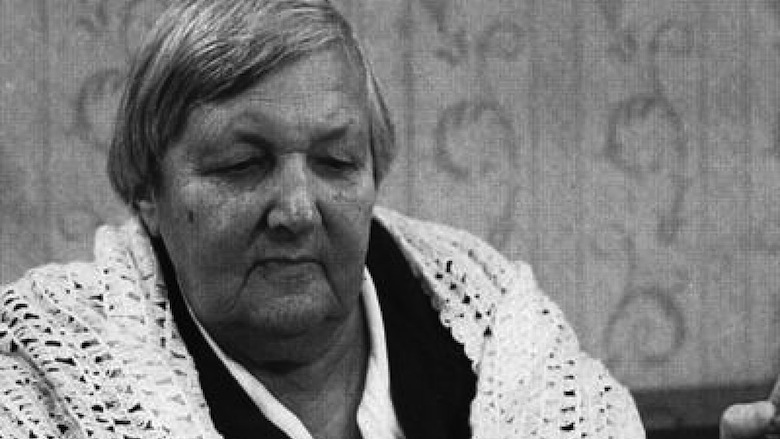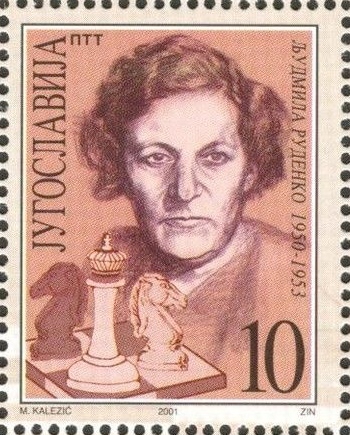
Wikipedia Commons Lyudmila Rudenko
Ukrainian chess player Lyudmila Rudenko is being celebrated with a Google Doodle on what would have been her 114th birthday.
As an International Master in the World Chess Federation (FIDE) and later Woman Grandmaster,” Google writes in its description, “Rudenko made a career paving the way for women to come… In 1950, Rudenko became the second woman ever to win the Women’s World Chess Championship—a title she held until 1953.”
In addition to her prowess on the chess board, Rudenko helped organize the evacuation of children during the Siege of Leningrad in World War II– an accomplishment she felt was the most important of her life.
Here’s what you need to know about Lyudmila Rudenko:
1. She Began Playing Chess As a Hobby When She Was Attending College
Rudenko was born in Lubny, in the Poltava region of Ukraine, on July 27, 1904. She was taught by her father how to play chess, but she preferred swimming as a child, and would go on to became the swimming champion in the 400 m breaststroke at her Odessa school. In 1925, she was crowned the swimming vice-champion of Ukraine in the breaststroke category.
She obtained a degree in economics, and by 1929 she had moved to Moscow to begin her career as a member of the economic planning committee for the Soviet Union. It during this period of her life that she began to nourish her interest in chess. Rudenko began playing tournament chess in the late 1920s, and in 1928, she won the Moscow Women’s Championship.
2. She Organized a Train to Evacuate Children From the Siege of Leningrad

Wikipedia CommonsLyudmila Rudenko
Rudenko’s career as a chess player continued to gain traction throughout the 1930s and 40s, but it was put on hold when World War II broke out. Now living in Leningrad, Rudenko aided the surrounding denizens and organized a massive evacuation of children during the siege of the city. The siege went on for two years, killing around four million militants and hundreds of thousands more civilians.
It is unclear how many children Rudenko saved with her efforts, but the chess player often referred to it as the “most important thing” she’d ever done. After World War II ended, her chess career resumed, and she participated in the historic “Radio Match Great Britain” in 1946. It was the first event organized by the
“Anglo – Russian” chess club, and it was promptly recognized by both chess federations.
According to AMICI, the match was an opportunity to demonstrate
the friendship between the two countries. The rooms where the games
were played, were decorated with the flags of the two countries, and many
British officials visited during the games.
3. She Became the 2nd Woman to Win the Women’s World Chess Championship In 1950
After Vera Menchik, the Women’s World Champion, died during an air raid in 1944, a tournament was organized to determine her successor. So, in the winter of 1949, the World Chess Federation FIDE held a tournament in Moscow to determine the new women’s champion. Sixteen women from twelve different countries competed, including Rudenko.
With a record nine wins, one loss, and five draws, Rudenko became the new Women’s World Champion in 1950. She was 40 years old. She held the title until 1953, when she lost to Elisaveta Bykova. In his book Soviet Chess, author D.J. Richards details the conditions under which Rudenko competed.
“Chess became an intellectual cause celebre in the Soviet Union. Success in the game was an important demonstration of the success of the Revolution, inside and outside the country,” he wrote. “Chess masters became intellectual ambassadors, and it was nationally important that they be perceived as successful.”
Richards also wrote of the stipulations that women who competed had to contend with. “Grandmaster Nikolai Krogius, on behalf of the Soviet chess federation, wouldn’t allow questions to be asked of their women players regarding their creative strengths, whether they be imaginative or based on technique,” he added.
4. She Has One Son With Her Husband Lev Davidovich Goldstein
Rudenko was married to scientist Lev Davidovich Goldstein, the founder of the department of cybernetics in the military academy named after Mozhaisky. A close friend of Rudenko’s, E. Bishard, says that there is still a plaque honoring Goldstein at the academy. In 1931, the couple gave birth to their only son, Vladimir. “She was playing chess, she was bringing up her son and working at a printing-office,” recalls Bishard. “It was a severe time.”
After World War II, Rudenko dedicated herself to playing chess full-time. She and her family were welcoming of other players, and would often invite them to stay at their home. “She loved people, received guests hospitably and kept an open table,” said Bishard. “When chess players from other cities came and had no place to stay, she spread a big carpet on the floor so that everybody could sleep. She was hot-tempered, liked the process of playing and the result.”
In addition to chess, Bishard said that Rudenko also had an interest in collecting art and books. “She had an excellent library, the books were alive for her,” she said. “She liked to present them and lend for reading.”
5. She Was Inducted Into the World Chess Hall of Fame In 2015

Wikipedia CommonsLyudmila Rudenko stamp
Rudenko went on to earn chess titles well into her old age, including the title of International Master and the 1976 Woman Grandmaster. She eventually passed away at the age of 81 on March 4, 1986. In 2015, she was inducted into the World Chess Hall of Fame.
“2004 is the year of centenary of the first Soviet woman’s world champion,” Bishard wrote, commemorating her old friend. “International woman’s chess tournament is held in Petersburg in her memory. Young chess players take part in it, they play, they play in a new way, advocating new principles.”
“They haven’t seen [Rudenko] while alive, she is a symbol for them – world champion,” she concluded. “Yes, she is a symbol, symbol of the past epoch, embodiment of its best features.”